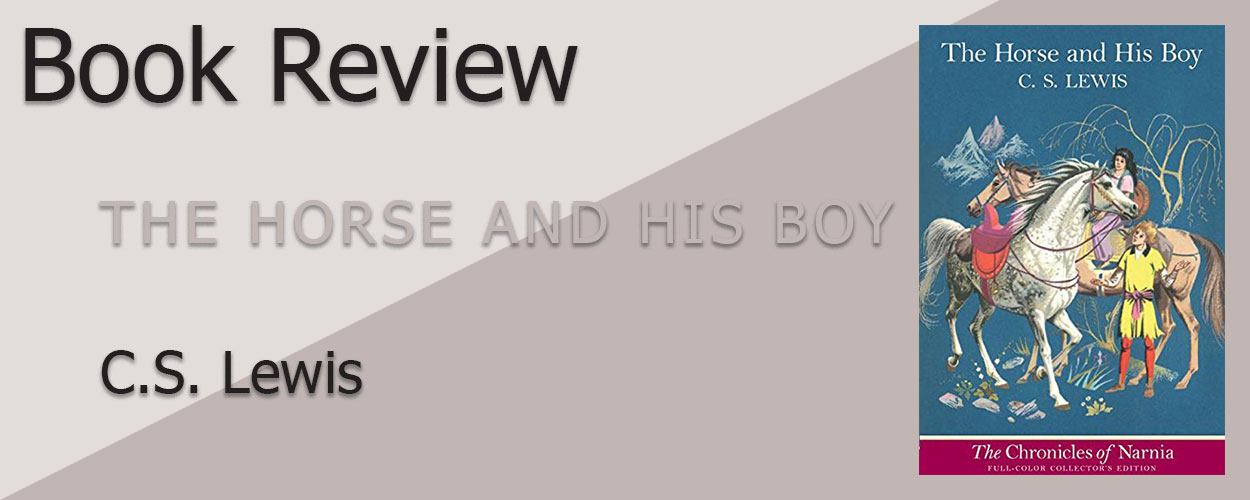

I really liked it
Book three of this series! I have no idea what to expect, but from the cover image, it doesn’t look like the four Pevensie kids are the main characters in this one.
Read: June 17 – June 21, 2024
Genre: Classic, Fairy Tale
Audience: Children
Book contains: slavery, kidnapping, mentions of underage marriage, attempt of conquest, death, non-consensual animal transformation
Purchase a copy from Amazon.ca
Shasta, a boy from the country of Calormen, makes his escape just before his adopted father sells him as a slave to a lord. He and the lord’s horse, who is secretly a kidnapped and enslaved talking horse from Narnia, journey northward to find the free country of Aslan the lion, meeting allies and facing perils along the way.
Firstly, I kind of love the title: the horse and his boy. There is a line in the book explaining this exact sentiment, but without knowing it, it still catches the eye. Why this way around? So great.
The storyteller role has once again been taken on by C.S. Lewis, who writes in third person omniscient. As he tells the story, he pauses occasionally to add extra thoughts and to directly address the reader.
This was a delightful book to read out on my covered balcony, since the summer months have brought warm weather. I can sit in the shade and enjoy a good old-fashioned story.
Once again, we have a group of four main characters: two children and two talking horses from Narnia as they undertake the journey of escape. It seems like fate is against them, but I love how, even though they become separated at times, they connect with each other and become a team so easily, despite the mistrust they’ve all learned from their hard lives.
There are certainly pairs here, as each horse and their human child set out on this journey together. Bree (the stallion) seems to take on a father-like role with Shasta, supporting him and teaching him the proper way to ride (without use of a bridle). Aravis and Hwin are another pair who escaped together and already have a close bond that only grows deeper after Aravis learns that “her horse” can speak.
The group’s goal is a simple one: go north to Narnia. But it’s a lot easier said than done. They are both being pursued for different reasons, and the trek to Narnia itself takes them across a vast desert and through dangerous lands. The writing style follows the same pattern as Lewis’s other books, making it fun and exciting for young readers while also weaving in real-world dangers and harsh realities.
Right away, the story introduces the main character and some of the mystery surrounding him. Shasta and Bree escape together and face threats that keep the reader’s attention engaged. There are slower points within the story as well, but nothing that seems to drag the story down, as the conversations only add to the intrigue of the mystery surrounding Shasta’s origin that they didn’t even know was there.
Even if it doesn’t directly follow the story of the four children from the original story (and can be read entirely as a standalone book) I highly recommend reading this book—and reading it in series order.
The Chronicles of Narnia Book 1: The Magician’s Nephew by C.S. Lewis
The Chronicles of Narnia Book 2: The Lion, the Witch, and the Wardrobe by C.S. Lewis
The Chronicles of Narnia Book 3: The Horse and His Boy by C.S. Lewis
The Chronicles of Narnia Book 4: Prince Caspian by C.S. Lewis
The Chronicles of Narnia Book 5: The Voyage of the Dawn Treader by C.S. Lewis
The Chronicles of Narnia Book 6: The Silver Chair by C.S. Lewis
The Chronicles of Narnia Book 7: The Last Battle by C.S. Lewis
A Series of Unfortunate Events Book 1: The Bad Beginning by Lemony Snicket
Alice in Wonderland Book 1: Alice’s Adventures in Wonderland by Lewis Carroll
*The Wicket by Carlee Coton*
Coraline by Neil Gaiman
Tigerpetal Press is a small book press dedicated to publishing local authors and poets.